
Calcium hydroxide (traditionally called slaked lime) is an inorganic compound with the chemical formula Ca(OH)2. It is a colorless crystal or white powder and is produced when quicklime (calcium oxide) is mixed with water. It has many names including hydrated lime, caustic lime, builders' lime, slaked lime, cal, and pickling lime. Calcium hydroxide is used in many applications, including food preparation, where it has been identified as E number E526. Limewater, also called milk of lime, is the common name for a saturated solution of calcium hydroxide.
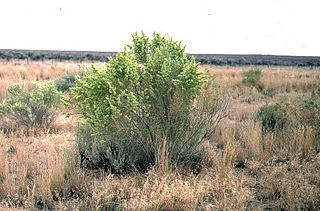
Saltbush is a vernacular plant name that most often refers to Atriplex, a genus of about 250 plants distributed worldwide from subtropical to subarctic regions. Atriplex species are native to Australia, North and South America, and Eurasia. Many Atriplex species are halophytes and are adapted to dry environments with salty soils.

Nixtamalization is a process for the preparation of maize, or other grain, in which the grain is soaked and cooked in an alkaline solution, usually limewater, washed, and then hulled. The term can also refer to the removal via an alkali process of the pericarp from other grains such as sorghum.
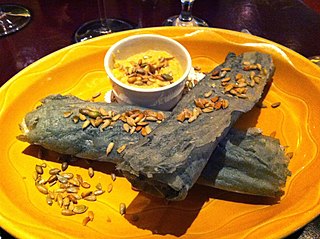
Piki is a bread made from blue corn meal used in Hopi cuisine.

Amaranthus blitoides, commonly called mat amaranth, prostrate pigweed, procumbent pigweed, prostrate amaranth, or matweed, is a glabrous annual plants species. It usually grows up to 0.6 m, though it may grow up to 1 m. It flowers in the summer to fall.

Atriplex confertifolia, the shadscale or spiny saltbush, is a species of evergreen shrub in the family Amaranthaceae, which is native to the western United States and northern Mexico.

Rhus trilobata is a shrub in the sumac genus (Rhus) with the common names skunkbush sumac, sourberry, skunkbush, and three-leaf sumac. It is native to the western half of Canada and the Western United States, from the Great Plains to California and south through Arizona extending into northern Mexico. It can be found from deserts to mountain peaks up to about 7,000 feet (2,100 m) in elevation.

Dysphania atriplicifolia is species of flowering plant known by the common names winged pigweed, tumble ringwing, plains tumbleweed, and tumble-weed. This plant is native to central North America, but it is spreading and has been occasionally reported in far-flung areas from California to Maine to the Canadian prairie. It is considered an introduced species outside of central North America. This is a bushy annual herb forming a rounded pale green clump which may exceed 0.5 m in height. It is very intricately branched, with toothed leaves occurring near the base. The spreading stems bear widely spaced flowers are small immature fruits fringed with a nearly transparent membranous wing. In autumn, the plant forms a tumbleweed. The fruit is a utricle about 2 millimeters long containing a single seed.

Eriogonum jamesii is a species of wild buckwheat known by the common name James' buckwheat and antelope sage. It is native to the southwestern United States, being found in: Colorado, Utah, Arizona, Texas, New Mexico, Oklahoma, and Nebraska.

Atriplex argentea is a species of saltbush known by the common names silverscale saltbush and silver orache. It is native to western North America from southern Canada to northern Mexico, where it grows in many types of habitat, generally on saline soils.
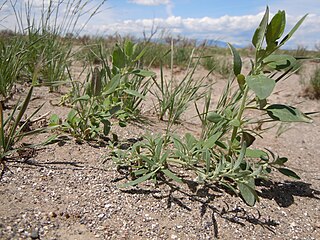
Chenopodium leptophyllum is a species of flowering plant in the family Amaranthaceae known by the common name narrowleaf goosefoot.

Abronia fragrans, the sweet sand-verbena, snowball sand-verbena, prairie snowball or fragrant verbena, is a species of sand verbena.
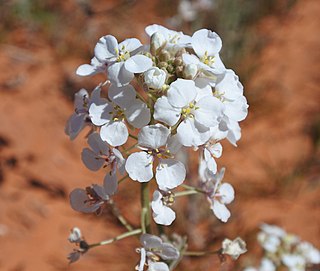
Dimorphocarpa wislizeni, commonly known as spectacle pod, Wislizeni's spectaclepod, and touristplant, is a flowering plant in the mustard family native to western North America, where it occurs in the southwestern United States as far east as Oklahoma and Texas, and Baja California, Sonora, Chihuahua, and Coahuila in Mexico.
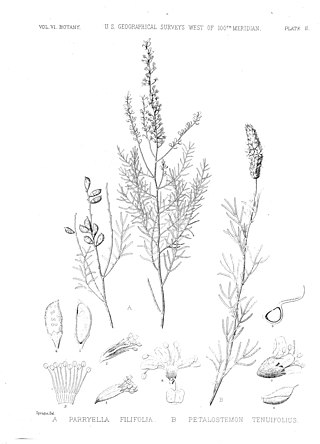
Parryella filifolia, the common dunebroom, is a species of flowering plants in the family Fabaceae. It belongs to the subfamily Faboideae. It is the only member of the genus Parryella. It is native to Arizona, Colorado and New Mexico.
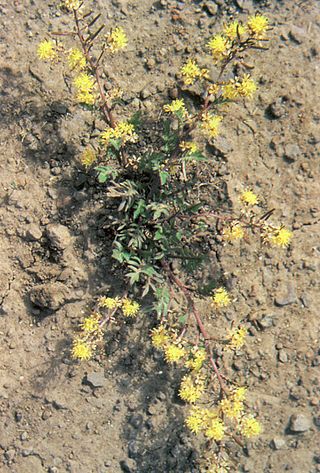
Rorippa sinuata is a species of flowering plant in the family Brassicaceae known by the common name spreading yellowcress. It is native to North America, including most all of the western and central United States, where it grows in many types of moist and wet habitat, such as lakeshores and riverbanks, meadows, and mudflats. It is a perennial herb producing spreading stems up to 40 or 50 centimeters long. It is densely hairy, the hairs rounded like sacs or vesicles. The leaves are up to 8 centimeters long and have blades are deeply toothed, lobed, or divided into smaller leaflets. The inflorescence is an elongated raceme occupying the top portion of the stem containing many tiny yellow flowers just a few millimeters long. The fruit is a curved silique which is variable in size and shape but generally contains many minute seeds.

Erigeron rhizomatus is a rare species of flowering plant in the family Asteraceae known by the common names Zuni fleabane and rhizome fleabane. It is native to western New Mexico and eastern Arizona in the United States. It is a federally listed threatened species.
This is a list of plants and how they are used in Zuni culture.

Oenothera albicaulis is a New World plant in the evening primrose family. It is known by the common names prairie evening-primrose, white-stem evening-primrose, whitish evening primrose, or whitest evening primrose.

Eriogonum alatum, with the common names winged buckwheat and winged eriogonum, is a species of buckwheat.
Saltbush scrub is a Mojave Desert plant community and vegetation type, found above and beyond the alkali sink Shadscale scrub type.



















